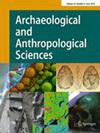Zooarchaeological perspectives on the medieval consumptionscape at Monte Iato (Sicily)
Abstract
This paper presents faunal remains from medieval Monte Iato in Western Sicily. Five assemblages from independent architectural structures in close spatial proximity are discussed. The architectural features from which the material was recovered date to the 13th century AD. At this time Monte Iato was a stronghold of insurrectionists under Arab leadership against Emperor Frederick II. During the ensuing power struggles the settlement on the mountain plateau was destroyed twice according to literary sources – in 1222/1223 AD and again in 1246 AD. Faunal remains from this time highlight different synchronous consumption patterns in close proximity. Three architectural units show a basic subsistence strategy focussing predominantly on sheep and goat. The other two units diverge significantly. Faunal remains from one house show a high percentage of deer and equid remains which can tentatively be linked to an elevated social status. The material from another house is dominated by pig, possibly due to a high proportion of residual bones. While the assemblages’ diverging patterns were in part created by contrasting taphonomic pathways, they may also reflect the different socio-economic status of the consumers involved.

 求助内容:
求助内容: 应助结果提醒方式:
应助结果提醒方式:


